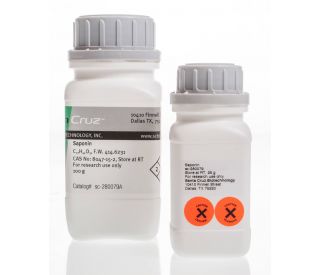
ChemCruz™ Saponin,采用安全、高品质的容器包装,是一种多功能、研究级化合物,适用于实验室应用。标签清晰,可安全、有效地处理。
Saponin (CAS 8047-15-2)
查看产品引用文献(7)
快捷链接
订购信息
产品相关文献索引
描述
技术信息
安全信息
安全技术说明书和分析证明书
皂苷是一种促进蛋白质穿透细胞膜的次生代谢物。研究表明,皂苷是一种两亲性糖苷,可以作为溶血剂。研究表明,皂苷具有镇痛、抗炎和解热作用,这可能是由于其非糖苷部分,即皂苷元。皂苷还可以用于环境研究,从污泥样本中回收铬和其他金属。其他研究表明,皂苷可用于免疫测定,因为它可以刺激Th1免疫反应和细胞毒性T淋巴细胞产生,以应对外源性抗原。
Saponin (CAS 8047-15-2) 参考文献
- 皂素类佐剂的研究进展。 | Sun, HX., et al. 2009. Vaccine. 27: 1787-96. PMID: 19208455
- 利用皂素和氧化修复技术从制革污泥中回收铬。 | Kiliç, E., et al. 2011. J Hazard Mater. 185: 456-62. PMID: 20940084
- Quillaja saponaria Mol.皂苷提取物, 紫苏酸及其衍生物对小鼠的抗镇痛活性。 | Arrau, S., et al. 2011. J Ethnopharmacol. 133: 164-7. PMID: 20951193
- 皂素和皂素-壳聚糖体系的表面特性和发泡性。 | Santini, E., et al. 2019. Colloids Surf B Biointerfaces. 181: 198-206. PMID: 31136951
- 皂素促进抗 Robo1 免疫毒素对上颌窦鳞状细胞癌的细胞毒作用 | Komatsu, N., et al. 2020. J Oncol. 2020: 9593516. PMID: 32256588
- 油基单价(O 血清型)口蹄疫病毒疫苗中的皂素对豚鼠和牛抗体反应的佐剂效应。 | Bazid, AI., et al. 2021. Arch Virol. 166: 1977-1984. PMID: 33871696
- 通过渐进式冷冻浓缩和灭菌处理稳定皂苷。 | Osman, WNAW., et al. 2021. Molecules. 26: PMID: 34443445
- 用 HPLC-UV/CAD 评估适应林同省气候的越南三七中的皂苷含量。 | Nguyen, HT., et al. 2021. Molecules. 26: PMID: 34500805
- 利用全基因组测序分析内生真菌Fusarium sp. | Ding, C., et al. 2022. J Basic Microbiol. 62: 623-633. PMID: 35411947
- 皂素浓度, 分子标记和生化因子与增强紫花苜蓿幼苗受潮的抗性之间的关系。 | Azzam, CR., et al. 2022. Saudi J Biol Sci. 29: 2148-2162. PMID: 35531163
- 以皂素和壳聚糖为基础的病毒性出血性败血症病毒(VHSV)口服疫苗可为橄榄鲽(Paralichthys olivaceus)提供保护性免疫。 | Jung, MH., et al. 2022. Fish Shellfish Immunol. 126: 336-346. PMID: 35643353
- 铁蛋白纳米颗粒包裹的皂苷可减轻小鼠肺炎球菌肺炎。 | Safdarpour, S., et al. 2022. Microb Pathog. 172: 105731. PMID: 36041710
- 皂素通过TLR4/TRIF/NF-κB信号通路减轻柴油机废气颗粒(DEP)诱导的气道上皮细胞和卵清蛋白(OVA)致敏小鼠的MUC5AC表达和促炎细胞因子上调。 | Jo, S., et al. 2022. J Ginseng Res. 46: 801-808. PMID: 36312733
- 皂素-壳聚糖混合物的表面特性 | Krzan, M., et al. 2022. Molecules. 27: PMID: 36364333
- 利用皂素制备 β-环糊精/多糖泡沫。 | Petitjean, M. and Isasi, JR. 2023. Beilstein J Org Chem. 19: 78-88. PMID: 36761472
订购信息
| 产品名称 | 产品编号 | 规格 | 价格 | 数量 | 收藏夹 | |
Saponin, 25 g | sc-280079 | 25 g | $43.00 | |||
Saponin, 100 g | sc-280079A | 100 g | $108.00 | |||
Saponin, 1 kg | sc-280079B | 1 kg | $989.00 |
